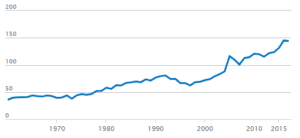The international development industry is vast. When official development assistance (aid offered by wealthy countries for the “economic development and welfare of developing countries”) and other forms of aid including disaster and relief are taken into account, the industry spends upwards of $200 billion annually. In some countries, such as Malawi, Mali, and Uganda, official development assistance funds more than half of government expenditures. The verdict on the efficacy of the foreign aid industry however, is mixed. While some make the case that wealthy countries should give more, other economists argue that aid fuels corruption, dependency, and props up dictators. Both arguments are compelling, but they beg the question: what feasible alternatives to providing aid even exist?
In the beginning
In his book, The History of Development, Gilbert Rist explains how the modern day development industry took off in 1949, initially as a “public relations gimmick.” During President Harry Truman’s inaugural address, also known as the Four Points Speech, he asked Americans to “embark on a bold new program for making the benefits of our scientific advances and industrial progress available for the improvement and growth of underdeveloped areas.” In his speech, the president framed the problem of the “undeveloped areas” as a lack of resources and the proposed solution to the “misery” of those in poor nations as a transfer of resources, both financial and technical. This public speech ultimately made way for the beginning of the professionalization and the industrialization of development.
This speech, unbeknownst to the president, would give rise to the first global United States Foreign Aid Program. The fourth point in the president’s speech about helping undeveloped areas led to the creation of the Technical Cooperation Administration (TCA), which ultimately became the United States Agency for International Development (USAID). And just like that, the modern day development industry, designed to transfer resources from wealthy nations to poor or “underdeveloped” ones, was born. And it hasn’t looked back since.
Official Development Assistance from OECD countries in USD Billion (2016 prices & exchange rates)
Source: http://www.compareyourcountry.org
The distributors emerge
Prior to Truman’s speech, economic development had been a delicate dance, primarily between two major stakeholders: innovators and governments. Innovators created new markets which in turn created new jobs and infrastructure. As these markets and infrastructures grew, governments began regulating them and creating institutions that ensured the safety of its citizens. But since the industrialization of development, many other stakeholders—multilateral organizations, foreign aid programs from high-income countries, development economists mostly from high-income countries, charities, multinational corporations, low-income country governments—have become more prominent players in the economic development discourse. Unfortunately, most of the stakeholders in the industry have never developed an innovation, managed a business, or created a market and subsequently, the role of the innovator and entrepreneur in development has taken a backseat.
Instead, many of the industry’s players are experts at distributing resources. From loans to schools to hospitals, and even to good governance, we have created a system that is adept at distributing, measuring, and developing success metrics for the resources it distributes.
In a recent World Bank paper which focuses on assessing how well our distribution of soft infrastructure (institutions, governance systems, and so on) has worked, the authors write that, “Project indicators typically reflect an emphasis on attainment of [or transfer of] best practice rather than fixing of the original problem.” The authors found that only about 30% of projects they analyzed actually measured for actual performance improvements. The remaining measured how different the new “institution” looked compared to the old one. This, they conclude, “leads to a distorted view of project success.” From the schools that are built to the hospitals that are funded, unfortunately, this constant transfer of resources creates quite a lot of motion and not necessarily much progress.
Why is this the case?
The main reason why we’re seeing so little progress is because resources, whether financial or technical, are often transferred from wealthy countries to poor with little consideration of local capabilities. As discussed in a previous blog, for aid programs to be impactful local communities must be able to sustain them long after the donors step away, which means that a program’s size and complexity can’t exceed the recipient’s capability to sustain it. As an example, transferring resources as simple as water wells or as complex as sophisticated IT systems to improve governance, may be helpful initially, but the impact won’t endure if the local community lacks the personnel, the expertise, or the infrastructure to maintain them.
Jim Kim, president of the World Bank, likes to say “We are the first generation in human history that can end extreme poverty.” I believe he’s right, provided that we begin to focus less on the transfer of resources to poor countries and do more to harness the potential that already exists within these communities. Prosperity begins there.




